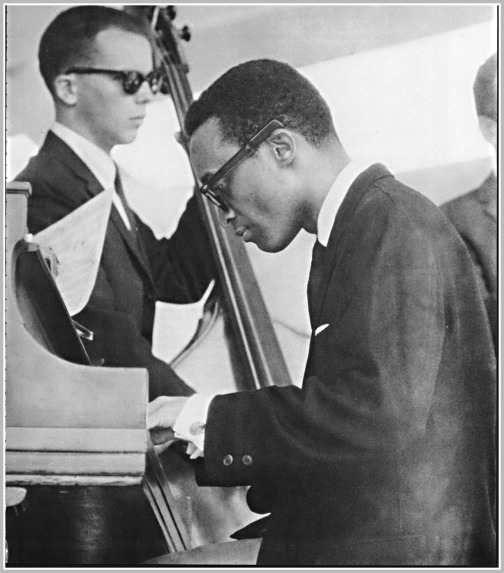Nérija at the Albert Hall

So maybe this London jazz boom is for real, after all. There was another piece about it in the New York Times last week, in which Giovanni Russonello extolled the Sons of Kemet’s new album while correctly praising the vibrancy of the scene that incubated Shabaka Hutchings and his colleagues. Last night I heard a bit more evidence in the intimate surroundings of the Albert Hall’s Elgar Room, where the septet called Nérija pulled a big and enthusiastic crowd.
Nérija are Sheila Maurice-Grey (trumpet), Rosie Turton (trombone), Cassie Kinoshi (alto saxophone), Nubya Garcia (tenor saxophone), Shirley Tetteh (guitar), Rio Kai (double bass) and Lizy Exell (drums). Several of them are graduates of the invaluable Tomorrow’s Warriors programme run for young musicians by Gary Crosby and Janine Irons. Last year they released an EP — you can listen to and download it here — which showed off qualities that were illustrated in greater depth during two half-hour sets packed with substantial original compositions, some of them written collectively and each showing a different facet of their character.
Their grooves are made for dancing, their tunes and solos for listening. The four-horn front line makes a pleasingly warm, fat sound, but is used with flexibility, sometimes dividing up within the written sections: trumpet and trombone together, or alto and tenor, or other combinations, thus keeping the textures fresh and the densities surprising. The solos are strategically placed within each composition so that the listener never gets the feeling of hearing a routine in progress. Often a piece has an unexpected ending: an epigrammatic tag, a rhythm section coda, a sudden diminuendo.
As soloists, the horn players are still developing but already show self-confidence and imagination. The formidable Garcia is currently the best known of them, but Maurice-Grey and Turton played several solos that would be outstanding in any context, while Kinoshi — whose playing has a bit of the Blue Notes’ Dudu Pukwana and the Skatalites’ Lester Sterling in it — preached with particular fervour on a composition of her own.
I love how they mix West and South African and Jamaican influences with hard bop and modal jazz, hip-hop, and no doubt other ingredients. The place where they all meet — the prism through which everything passes — seems to be the guitar of Tetteh, who powers the grooves with a fast, staccato chordal approach closer to funk than jazz, as well driving Kai and Exell to spirited climaxes behind the soloists. Her own improvisations are episodic but often contain startling juxtapositions of chordal passages with rippling single-note figures. I hear echoes of all sorts of things metabolised in her playing: Ernest Ranglin, Gabor Szabo, Michael Hampton, Grant Green, and the guys who played guitar with King Sunny Adé. I think she’s finding her way towards something special.
Although Nérija’s approach has been carefully planned, the music never feels tricksy. There are music stands on stage, but they don’t get in the way of spontaneity and a compelling immediacy. There are rough edges, but in a Mingus-y sort of way, which can only be good. You feel that if they were ever completely smoothed away, the fun would stop. Which hardly seems imminent.



 In the summer of 2000 I spent an hour across a table from Keith Jarrett in a rooftop restaurant overlooking the Baie des Anges in Nice. Infuriatingly, he chose to conduct the conversation while wearing mirror shades. An interviewer tries to establish some kind of rapport with his/her subject, in which eye contact plays a part; the shades meant that I spent the hour staring at reflections of myself. I thought it was discourteous, and possibly a bit passive-aggressive. Somewhat wryly, I thought back to the morning 30 years earlier when he had wandered unannounced into the offices of the Melody Maker, a couple of days after his appearance with Miles Davis at the Isle of Wight, hoping to persuade someone to interview him.
In the summer of 2000 I spent an hour across a table from Keith Jarrett in a rooftop restaurant overlooking the Baie des Anges in Nice. Infuriatingly, he chose to conduct the conversation while wearing mirror shades. An interviewer tries to establish some kind of rapport with his/her subject, in which eye contact plays a part; the shades meant that I spent the hour staring at reflections of myself. I thought it was discourteous, and possibly a bit passive-aggressive. Somewhat wryly, I thought back to the morning 30 years earlier when he had wandered unannounced into the offices of the Melody Maker, a couple of days after his appearance with Miles Davis at the Isle of Wight, hoping to persuade someone to interview him.

